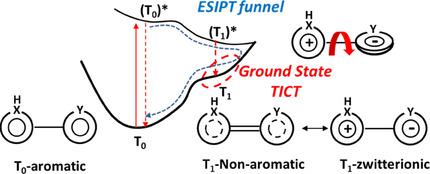当前位置:
X-MOL 学术
›
Isr. J. Chem.
›
论文详情
Our official English website, www.x-mol.net, welcomes your
feedback! (Note: you will need to create a separate account there.)
Design of Light‐Induced Molecular Switcher for the Driver of the Quantum Cellular Automata (QCA) Based on the Transition through the Intramolecular Charge Transfer (ICT) Structure
Israel Journal of Chemistry ( IF 2.3 ) Pub Date : 2020-01-27 , DOI: 10.1002/ijch.201900148 Shmuel Zilberg 1
Israel Journal of Chemistry ( IF 2.3 ) Pub Date : 2020-01-27 , DOI: 10.1002/ijch.201900148 Shmuel Zilberg 1
Affiliation

|
The design of light‐induced switcher for the molecular QCA driver was discussed. The driver‐cell with two connected chromophores was proposed as a basic model of the molecular light‐induced trigger. One of the chromophores will conjugate with a left diagonal and the second chromophore will conjugate with a right diagonal. Some differences between two chromophores can allow selective controlling of the switch to the left or to the right. The following three‐steps mechanism for QCA switcher was suggested – light‐induced transition through ICT area (a), initiation of the driver‘s polarization (b) and the beginning of the signal transition to the other cells (c). The principal physical characteristics of the driver‘s trigger was proposed, and the corresponding chemical implementation was discussed. Three kinds of processes leading to ICT were discussed as mechanisms suggested for potential switchers: 1) Irradiation leading to the ICT excited state; 2) Chemical reaction with ICT transition state; 3) Excited State Intramolecular Proton Transfer (ESIPT). The common features of these processes are the non‐radiative transition to the initial state after excitation, with the back transition going through the highly polar charge transfer (CT) area.
中文翻译:

基于分子内电荷转移(ICT)结构转变的量子细胞自动机(QCA)驱动器的光诱导分子开关设计
讨论了用于分子QCA驱动器的光感应开关的设计。带有两个连接的生色团的驱动单元被提议为分子光诱导触发的基本模型。一个生色团将与左对角线共轭,第二个生色团将与右对角线共轭。两个生色团之间的某些差异可允许有选择地控制向左或向右切换。提出了QCA切换器的以下三步机制–光通过ICT区域的过渡(a),驱动器极化的起始(b)和信号过渡到其他小区的开始(c)。提出了驾驶员扳机的主要物理特性,并讨论了相应的化学实现方式。讨论了导致信息通信技术的三种过程,作为可能的转换者建议的机制:1)辐射导致信息通信技术激发态;2)具有ICT过渡态的化学反应;3)兴奋态分子内质子转移(ESIPT)。这些过程的共同特征是激发后从非辐射跃迁到初始状态,反向跃迁通过高极性电荷转移(CT)区域。
更新日期:2020-01-27
中文翻译:

基于分子内电荷转移(ICT)结构转变的量子细胞自动机(QCA)驱动器的光诱导分子开关设计
讨论了用于分子QCA驱动器的光感应开关的设计。带有两个连接的生色团的驱动单元被提议为分子光诱导触发的基本模型。一个生色团将与左对角线共轭,第二个生色团将与右对角线共轭。两个生色团之间的某些差异可允许有选择地控制向左或向右切换。提出了QCA切换器的以下三步机制–光通过ICT区域的过渡(a),驱动器极化的起始(b)和信号过渡到其他小区的开始(c)。提出了驾驶员扳机的主要物理特性,并讨论了相应的化学实现方式。讨论了导致信息通信技术的三种过程,作为可能的转换者建议的机制:1)辐射导致信息通信技术激发态;2)具有ICT过渡态的化学反应;3)兴奋态分子内质子转移(ESIPT)。这些过程的共同特征是激发后从非辐射跃迁到初始状态,反向跃迁通过高极性电荷转移(CT)区域。











































 京公网安备 11010802027423号
京公网安备 11010802027423号